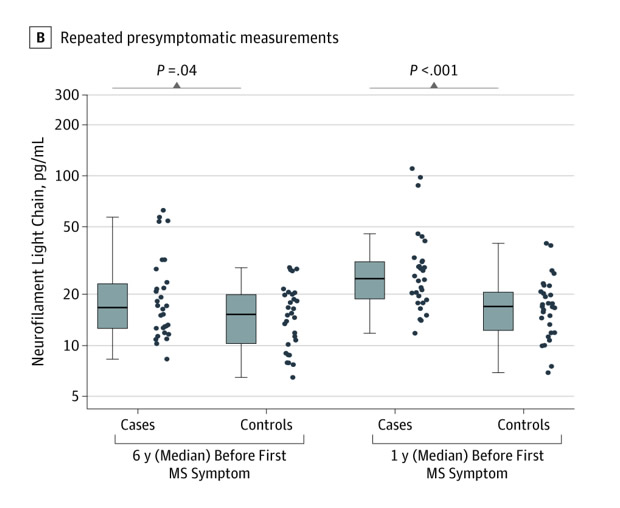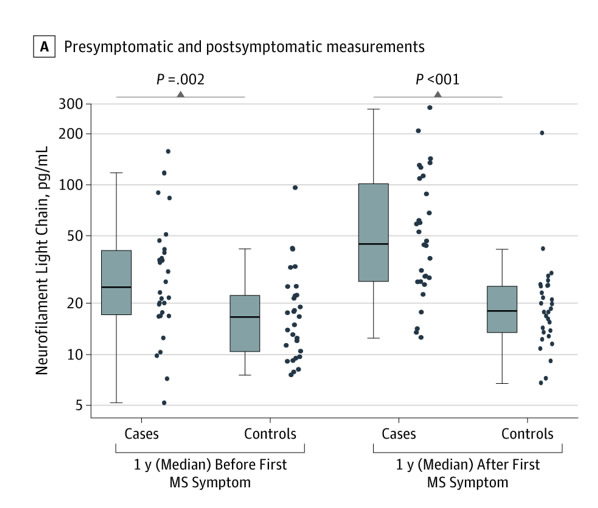Military Personnel Study Could Improve MS Treatment
BOSTON—Early identification of multiple sclerosis could enable interventions to prevent demyelinating events and the progression of neurodegeneration, as well as help pinpoint causal factors of the disease.
A study in JAMA Neurology noted that identifying multiple sclerosis (MS) earlier in disease progression would allow more accurate identification of the relevant period of exposure to potential etiological factors.1
Harvard T.H. Chan School of Public Health-led researchers conducted a study to assess whether the levels of serum neurofilament light chain (sNfL), a sensitive biomarker of ongoing neuroaxonal degeneration, were higher than expected in the years before and around the time of clinical onset. If so, that could be a direct marker of the prodromal phase of MS, the authors pointed out.
The nested case-control study was conducted among U.S. military personnel who have serum samples stored in the DoD Serum Repository. Results indicated that levels of serum neurofilament light increased six years before the clinical onset of MS.
“Our research suggests that MS can have a preclinical phase lasting several years. This means that MS can potentially be discovered earlier than it is today,” Kjetil Bjornevik, MD, PhD, of Harvard T.H. Chan School of Public Health in Boston, told U.S. Medicine.
“Earlier detection of MS would give the opportunity to start treatment earlier,” Bjornevik said. “Early treatment has been associated with better long-term outcomes for MS patients.”
Background information in the article noted that unrecognized demyelinating events often precede the clinical onset of MS and that identification of these events at the time of occurrence would have implications for early diagnosis and understanding of causal factors for the disease.
As a result, the study team sought to assess whether serum neurofilament light chain levels are elevated in the preclinical stage of the disease, before patients experience neurological symptoms.
“Neurofilament light chain is a promising biomarker for multiple sclerosis. In MS patients, blood levels are elevated in periods when the patients experience more disease activity, and it can therefore be used to monitor the disease,” Bjornevik explained. “In our study, we wanted to examine whether blood levels of this biomarker were elevated before the first MS symptoms, as this could help us learn more about the preclinical phase of the disease.”

Boxplots of Serum Neurofilament Light Chain (sNfL) Levels in Presymptomatic and Symptomatic Case Patients With Multiple Sclerosis (MS) and Matched Control Individuals. The figure illustrates levels of sNfL in cases with MS with 1 presymptomatic and 1 postonset measurement (A) and with repeated presymptomatic measurements (B). Log-transformed sNfL levels were compared using paired 2-tailed t tests.

Serum samples were collected from 2000 to 2011, with sNfL assays and data analyses performed from 2018 to 2019. Included in the study were 60 case patients with MS, out of 245 identified. For each case, researchers randomly selected one of two previously identified control individuals matched by age, sex, race/ethnicity and dates of sample collection. The sample size was chosen based on the available funding.
Mean age at baseline was 27.5 years, and 92 of the 120 participants (76.7%) were men. The sNfL concentrations were measured using an ultrasensitive single-molecule array assay (Simoa), according to the study.
Results indicated that sNfL levels were higher in case patients with MS compared with their matched control individuals in samples drawn a median of six years (range, 4-10 years) before the clinical onset (median, 16.7 pg/mL; interquartile range [IQR], 12.6-23.1 pg/mL vs. 15.2 pg/m; IQR, 10.3-19.9 pg/mL; P = .04).
Continue Reading this Article: Clinical Onset

